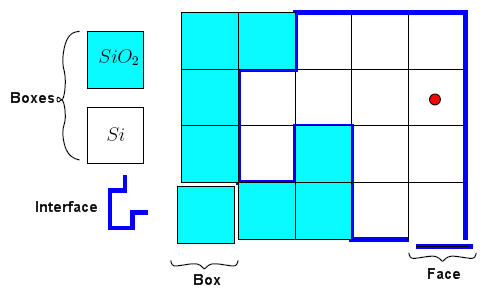The figure shows a DADOS interface implementation example. As the program makes a box division, the interface will be simulated as the interface among boxes of different materials (Rubio et al. 2003).

The probability of recombination of single neutral native defects on the interface is:

Where:
λ is the capture distance.
L is the recombination length, RecLnm_?.
As probabilities must be less or equal than 1:
If RecLnm_? < λ, DADOS makes RecLnm_? = λ and the interface will become a perfect sink for the selected particle.
If RecLnm_? = -1, DADOS automatically makes that interface neither emit or capture particles.
DADOS captures single neutral native defects with the probability explained.
Interface emission is much more frequent than emission in the bulk. Actually, DADOS doesn't implement emission in the bulk, as its frequency is extremely low.
Interface emission is only allowed for single neutral native defects. Frequency of surface emission per unit area is implemented following the expression below:

Where:
"?" stands for interstitials or vacancies.
p is the probability of recombination of single neutral native defects on the surface.
λ is the jump distance.
C0relEq_? is the relative single neutral native defects concentration under equilibrium conditions.
Dm_? is the prefactor of diffusivity.
Eform_? is the formation energy.
Em_? is the migration energy.
See symbol list.
For dopants, please see trapping mechanism.
Dopants have preferences for being emitted to one side from the interface. DADOS uses a coefficient to indicate the concentration of a dopant in the non-silicon side of the interface relative to the one in the silicon side. For calculating that, DADOS uses an Arrhenius plot:

Where:
Solubility is implemented in DADOS by means of "Cmax", which is the maximum solid solubility of dopant in the material, obtained with Csol0_? and Esol_0_? with an Arrhenius plot:

See symbol list.

See symbol list.
Interfaces in DADOS trap neutral mobile dopants. The flux of these phenomena has been implemented following the Oh-Ward model (Oh et al. 1998).
Net flux can be calculated as the difference between trapping rate and detrapping rate: F = T - D.
Trapping rate is defined as the attempted frequency for the process multiplied by the capture probability; this yields (Oh-Ward):

And detrapping rate can be calculated following the expression below:

Where:


Addition in trapping rate is calculated for all species present at the simulation.
Boron, arsenic and phosphorous are implemented in DADOS to diffuse through interfaces and go into other materials. As the properties here are quite unknown, DADOS only implements the diffusion for oxides and nitrides (neither extended defects formation nor interactions).
DADOS doesn't implement single neutral native defects for other materials different from crystalline silicon.